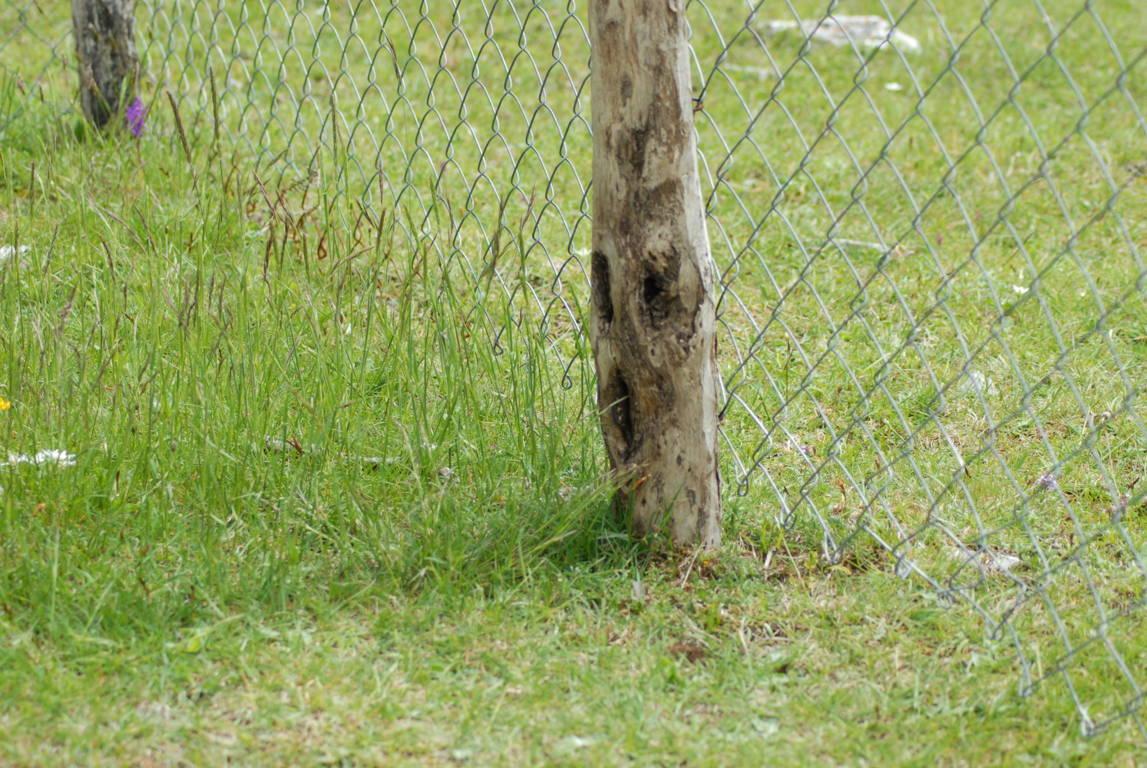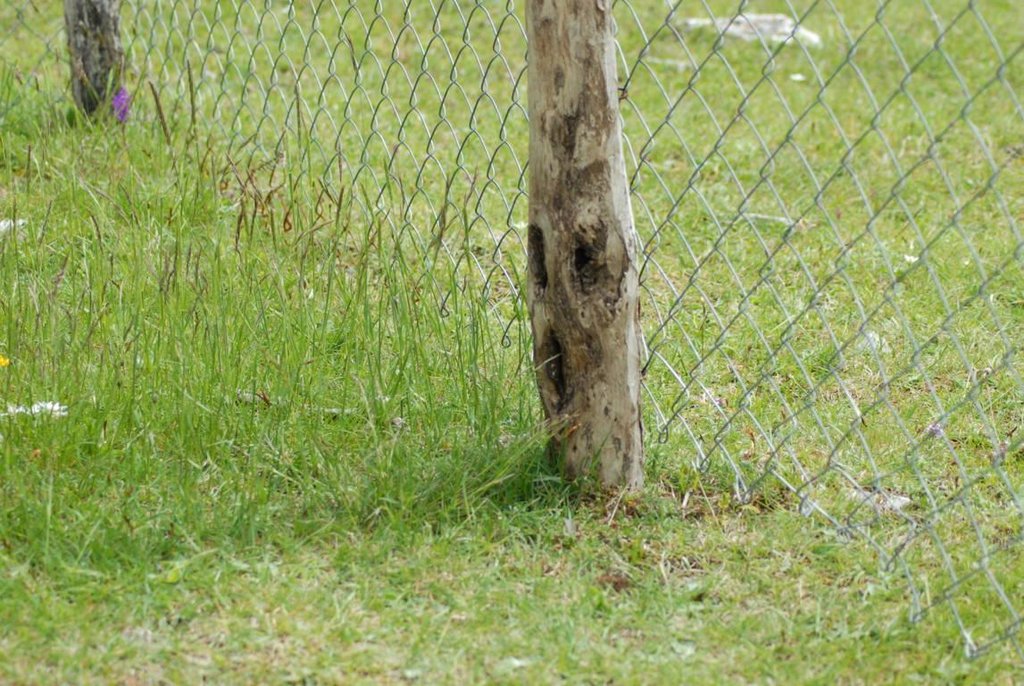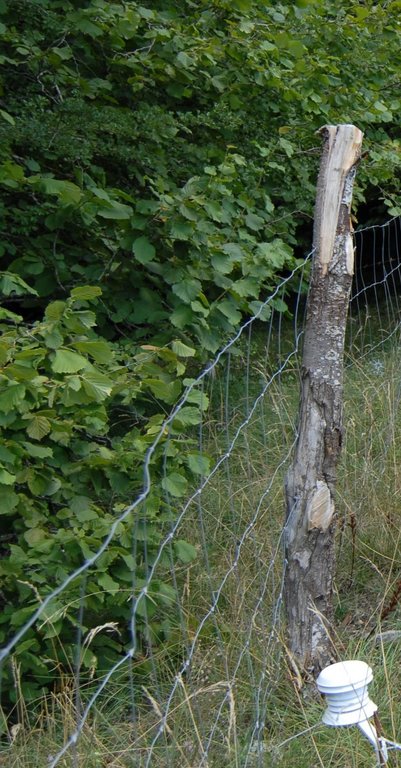Metallic fences to prevent damages to pastures from wild boars [意大利]
- 创建:
- 更新:
- 编制者: Velia De Paola
- 编辑者: –
- 审查者: Fabian Ottiger
technologies_1608 - 意大利
查看章节
全部展开 全部收起1. 一般信息
1.2 参与该技术评估和文件编制的资源人员和机构的联系方式
SLM专业人员:
Quaranta Giovanni
University of Basilicata
Via Nazario Sauro, 85, 85100 Potenza, Ita
意大利
有助于对技术进行记录/评估的项目名称(如相关)
Catastrophic shifts in drylands (EU-CASCADE)有助于对技术进行记录/评估的机构名称(如相关)
University of Basilicata - 意大利1.3 关于使用通过WOCAT记录的数据的条件
(现场)数据是什么时候汇编的?:
27/06/2014
编制者和关键资源人员接受有关使用通过WOCAT记录数据的条件。:
是
2. SLM技术的说明
2.1 技术简介
技术定义:
CONSTRUCTION OF FENCES TO KEEP WILD BOAR OFF PASTURE LAND
2.2 技术的详细说明
说明:
ẗhe regulations implemented by the Pollino national park to protect the wild fauna have led to large numbers of wild boar in the local area. Numbers of wild boar have also increased because of breeding with non-native species (a Hungarian strain) on the part of hunting associations. Numbers have increased so much that currently these animals have even reached rural areas destined for pasture, livestock farming and cultivation. To protect crops and pastures more fences have been built. Typically these fences are constructed out of pales made from local wood and galvanised iron netting.
Purpose of the Technology: Protection of pasture land and cropland
Establishment / maintenance activities and inputs: The construction of fences requires an initial investment in order to buy the wooden pales and iron netting. Generally the pales come from local woods, often from the farm itself, and are felled and prepared by local farmers who also usually construct the fences themselves. The height of the fences ranges from 1m to 1.20
Natural / human environment: Production methods are characterised by a medium level of mechanisation (only the most demanding operations are carried out using mechanical means), the production system is essentially mixed, a small part is destined for personal consumption whilst the bulk of production is destined for local markets. The property is predominantly privately owned but also includes some public land, especially in the case of pasture land. Most farms in the area are livestock farms whilst the agricultural component is destined exclusively for private consumption. The area is partially included in two bordered national parks, i.e. Pollino national park and val d’agri national park. This peculiar situation creates a very natural environment allowing the presence of many wild species.
2.3 技术照片
2.5 已应用该技术的、本评估所涵盖的国家/地区/地点
国家:
意大利
区域/州/省:
Basilicata
有关地点的进一步说明:
CASTELSARACENO
2.6 实施日期
如果不知道确切的年份,请说明大概的日期:
- 10-50年前
2.7 技术介绍
详细说明该技术是如何引入的:
- 通过土地使用者的创新
3. SLM技术的分类
3.2 应用该技术的当前土地利用类型

农田
- 一年一作

牧场
粗放式放牧场:
- 半游牧/游牧
- 经营牧场
主要动物种类及产品:
Main animal species ranching: Sheep/Goats/Cow
注释:
Major land use problems (compiler’s opinion): The wild boar tend to dig into the ground in search of food and, in doing so, leave soil open to processes of erosion and permanently degrade grass cover.
Major land use problems (land users’ perception): Severe damage to grass cover and crops
Semi-nomadism / pastoralism: Shepherds use the area for summer grazing and move downhill in winter
Mixed: (eg agro-pastoralism, silvo-pastoralism): A reduced number of farmers cultivate their field for fodder and pastures
Grazingland comments: Sheep and goats are the most valuable livestock
Type of grazing system comments: Sheep and goats are the most valuable livestock
3.3 有关土地利用的更多信息
注释:
Water supply: rainfed, mixed rainfed - irrigated
每年的生长季节数:
- 1
具体说明:
Longest growing period in days: 120Longest growing period from month to month: march to august
牲畜密度(如相关):
> 100 LU /km2
3.4 该技术所属的SLM组
- Protection of pasture land and cropland from wildlife
3.5 技术传播
具体说明该技术的分布:
- 均匀地分布在一个区域
如果该技术均匀地分布在一个区域上,请注明覆盖的大致区域。:
- 0.1-1 平方千米
3.6 包含该技术的可持续土地管理措施

结构措施
- S6:墙、障碍物、栅栏、围墙
注释:
Main measures: structural measures
3.7 该技术强调的主要土地退化类型

土壤水蚀
- Wt:表土流失/地表侵蚀

物理性土壤退化
- Pc:压实

生物性退化
- Bc:植被覆盖的减少
- Bh:栖息地丧失
- Bq:数量/生物量减少
- Bs:质量和物种组成/多样性的下降
注释:
Main type of degradation addressed: Wt: loss of topsoil / surface erosion, Bc: reduction of vegetation cover, Bq: quantity / biomass decline, Bs: quality and species composition /diversity decline
Secondary types of degradation addressed: Pc: compaction, Bh: loss of habitats
Main causes of degradation: increase and spreading of wild boars
Secondary causes of degradation: other human induced causes (specify) (Introduction of wild boars by hunting associations), governance / institutional (Excessive protection of the species by the National park)
3.8 防止、减少或恢复土地退化
具体数量名该技术与土地退化有关的目标:
- 防止土地退化
4. 技术规范、实施活动、投入和成本
4.2 技术规范/技术图纸说明
Technical knowledge required for land users: low
Secondary technical functions: improvement of ground cover, increase of biomass (quantity)
Structural measure: FENCES
Spacing between structures (m): 1pale/1.33m
Construction material (wood): Pales in wood
Construction material (other): Iron net (1 meter high)
4.3 有关投入和成本计算的一般信息
其它/国家货币(具体说明):
euro
注明美元与当地货币的汇率(如相关):1美元=:
0.74
注明雇用劳工的每日平均工资成本:
81.08
4.4 技术建立活动
| 活动 | 措施类型 | 时间 | |
|---|---|---|---|
| 1. | Wood pales and network | 结构性的 | every 20 years |
| 2. | wood pales | 结构性的 | |
| 3. | Iron net | 结构性的 |
4.5 技术建立所需要的费用和投入
| 对投入进行具体说明 | 单位 | 数量 | 单位成本 | 每项投入的总成本 | 土地使用者承担的成本% | |
|---|---|---|---|---|---|---|
| 劳动力 | Wood pales and network | 1000m | 1.0 | 5000.0 | 5000.0 | 100.0 |
| 施工材料 | Wood pales | Pales | 750.0 | 4.4144 | 3310.8 | 100.0 |
| 施工材料 | Iron net | 1000 meter | 1.0 | 5405.4 | 5405.4 | 100.0 |
| 技术建立所需总成本 | 13716.2 | |||||
注释:
Lifespan of the wood pales and network: 20 years
4.6 维护/经常性活动
| 活动 | 措施类型 | 时间/频率 | |
|---|---|---|---|
| 1. | Checking fence for repairs | 结构性的 | 6 times a year |
4.7 维护/经常性活动所需要的费用和投入(每年)
| 对投入进行具体说明 | 单位 | 数量 | 单位成本 | 每项投入的总成本 | 土地使用者承担的成本% | |
|---|---|---|---|---|---|---|
| 劳动力 | Checking fence for repairs | Day | 1.0 | 81.08 | 81.08 | 100.0 |
| 技术维护所需总成本 | 81.08 | |||||
4.8 影响成本的最重要因素
描述影响成本的最决定性因素:
The total cost for the construction of 1,000 metres of fencing is spread over a period of 20 years on the basis of the duration of the structure
5. 自然和人文环境
5.1 气候
年降雨量
- < 250毫米
- 251-500毫米
- 501-750毫米
- 751-1,000毫米
- 1,001-1,500毫米
- 1,501-2,000毫米
- 2,001-3,000毫米
- 3,001-4,000毫米
- > 4,000毫米
指定年平均降雨量(若已知),单位为mm:
1519.00
有关降雨的规范/注释:
68% in winter and 15% in summer
农业气候带
- 半湿润
Thermal climate class: temperate
5.2 地形
平均坡度:
- 水平(0-2%)
- 缓降(3-5%)
- 平缓(6-10%)
- 滚坡(11-15%)
- 崎岖(16-30%)
- 陡峭(31-60%)
- 非常陡峭(>60%)
地形:
- 高原/平原
- 山脊
- 山坡
- 山地斜坡
- 麓坡
- 谷底
垂直分布带:
- 0-100 m a.s.l.
- 101-500 m a.s.l.
- 501-1,000 m a.s.l.
- 1,001-1,500 m a.s.l.
- 1,501-2,000 m a.s.l.
- 2,001-2,500 m a.s.l.
- 2,501-3,000 m a.s.l.
- 3,001-4,000 m a.s.l.
- > 4,000 m a.s.l.
5.3 土壤
平均土层深度:
- 非常浅(0-20厘米)
- 浅(21-50厘米)
- 中等深度(51-80厘米)
- 深(81-120厘米)
- 非常深(> 120厘米)
土壤质地(表土):
- 细粒/重质(粘土)
表土有机质:
- 中(1-3%)
如有可能,附上完整的土壤描述或具体说明可用的信息,例如土壤类型、土壤酸碱度、阳离子交换能力、氮、盐度等。:
Soil fertility is medium-low
Soil drainage/infiltration is good
Soil water storage capacity is medium
5.4 水资源可用性和质量
地下水位表:
5-50米
地表水的可用性:
中等
水质(未处理):
良好饮用水
关于水质和水量的注释和进一步规范:
Availability of surface water is medium (minimum during month of September and October)
5.5 生物多样性
物种多样性:
- 中等
5.6 应用该技术的土地使用者的特征
生产系统的市场定位:
- 商业/市场
非农收入:
- 收入的10-50%
相对财富水平:
- 平均水平
个人或集体:
- 个人/家庭
性别:
- 男人
说明土地使用者的其他有关特征:
Land users applying the Technology are mainly common / average land users
Difference in the involvement of women and men: active farmers are present only males; women are not actively involved in land management
Population density: 10-50 persons/km2
Annual population growth: negative; 2%
and own 90% of the land.
and own 10% of the land.
Off-farm income specification: Most of the off farm income derives from public sector, i.e. Municipality, Mountain Community, Region and other public bodies. Very few farmer members run local shops or handcraft.
5.7 应用该技术的土地使用者拥有或租用的平均土地面积
- < 0.5 公顷
- 0.5-1 公顷
- 1-2 公顷
- 2-5公顷
- 5-15公顷
- 15-50公顷
- 50-100公顷
- 100-500公顷
- 500-1,000公顷
- 1,000-10,000公顷
- > 10,000公顷
这被认为是小规模、中规模还是大规模的(参照当地实际情况)?:
- 小规模的
注释:
Considering communal land used by farmers
5.8 土地所有权、土地使用权和水使用权
土地所有权:
- 社区/村庄
- 个人,有命名
土地使用权:
- 社区(有组织)
- 个人
5.9 进入服务和基础设施的通道
健康:
- 贫瘠
- 适度的
- 好
教育:
- 贫瘠
- 适度的
- 好
技术援助:
- 贫瘠
- 适度的
- 好
就业(例如非农):
- 贫瘠
- 适度的
- 好
市场:
- 贫瘠
- 适度的
- 好
能源:
- 贫瘠
- 适度的
- 好
道路和交通:
- 贫瘠
- 适度的
- 好
饮用水和卫生设施:
- 贫瘠
- 适度的
- 好
金融服务:
- 贫瘠
- 适度的
- 好
6. 影响和结论性说明
6.1 该技术的现场影响
社会经济效应
生产
饲料生产
SLM之前的数量:
7t/ha
SLM之后的数量:
8t/ha
生产故障风险
收入和成本
农业投入费用
农业收入
社会文化影响
SLM/土地退化知识
Improved livelihoods and human well-being
生态影响
水循环/径流
地表径流
土壤
土壤流失
土壤压实
生物多样性:植被、动物
生物量/地上C
有益物种
栖息地多样性
6.2 该技术的场外影响已经显现
对邻近农田的破坏
对公共/私人基础设施的破坏
6.3 技术对渐变气候以及与气候相关的极端情况/灾害的暴露和敏感性(土地使用者认为的极端情况/灾害)
渐变气候
渐变气候
| 季节 | 气候变化/极端天气的类型 | 该技术是如何应对的? | |
|---|---|---|---|
| 年温度 | 增加 | 好 |
气候有关的极端情况(灾害)
气象灾害
| 该技术是如何应对的? | |
|---|---|
| 局地暴雨 | 好 |
| 局地风暴 | 好 |
气候灾害
| 该技术是如何应对的? | |
|---|---|
| 干旱 | 好 |
水文灾害
| 该技术是如何应对的? | |
|---|---|
| 比较和缓的(河道)洪水 | 好 |
其他气候相关的后果
其他气候相关的后果
| 该技术是如何应对的? | |
|---|---|
| 缩短生长期 | 好 |
6.4 成本效益分析
技术收益与技术建立成本相比如何(从土地使用者的角度看)?
短期回报:
稍微积极
长期回报:
稍微积极
技术收益与技术维护成本/经常性成本相比如何(从土地使用者的角度看)?
短期回报:
稍微积极
长期回报:
稍微积极
6.5 技术采用
在所有采用这项技术的人当中,有多少人是自发地采用该技术,即未获得任何物质奖励/付款?:
- 0-10%
注释:
100% of land user families have adopted the Technology with external material support
Comments on acceptance with external material support: support by the national park
There is a little trend towards spontaneous adoption of the Technology
6.7 该技术的优点/长处/机会
| 土地使用者眼中的长处/优势/机会 |
|---|
|
If the National Park of Pollino would also support activities to prevent damage caused by wild boar instead of focusing solely on the conservation of wild local species (boar). How can they be sustained / enhanced? Greater economic support for the building of fences. |
| 编制者或其他关键资源人员认为的长处/优势/机会 |
|---|
|
The technology helps preserve pastures and protects against damage to crops How can they be sustained / enhanced? If the National Park of Pollino would also support activities to prevent damage caused by wild boar instead of focusing solely on the conservation of wild local species (boar). |
6.8 技术的弱点/缺点/风险及其克服方法
| 土地使用者认为的弱点/缺点/风险 | 如何克服它们? |
|---|---|
| Disadvantage solely related to high cost of construction. | More subsidies |
| 编制者或其他关键资源人员认为的弱点/缺点/风险 | 如何克服它们? |
|---|---|
| The only disadvantage is the high initial cost of building fences which is, however, partly mitigated by the possibility to use the fences also as boundary marker dividing one property from another. |
链接和模块
全部展开 全部收起链接
无链接
模块
无模块




